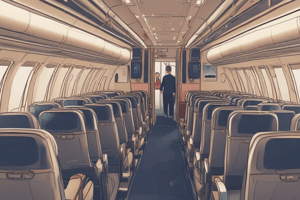Podcast
Questions and Answers
What is the purpose of the CIDS loudspeaker level adjustment function?
What is the purpose of the CIDS loudspeaker level adjustment function?
- To manually adjust the cabin loudspeaker output for announcements and chimes (correct)
- To configure cabin zones
- To control internal settings of the Flight Attendant Panel
- To monitor system performance and detect faults
What is the role of the Directors in the CIDS system architecture?
What is the role of the Directors in the CIDS system architecture?
- To adjust the loudspeaker level
- To fulfil the role of the controllers (correct)
- To connect components to the bus lines
- To monitor system performance and detect faults
What is the purpose of the Flight Attendant Panel set-up page?
What is the purpose of the Flight Attendant Panel set-up page?
- To adjust the loudspeaker level
- To monitor system performance
- To configure cabin zones
- To control internal settings including panel loudspeaker volume and screen brightness (correct)
In the CIDS system architecture, what is the relationship between the two Directors?
In the CIDS system architecture, what is the relationship between the two Directors?
What is the design approach used in the CIDS system?
What is the design approach used in the CIDS system?
What is the function of the CIDS directors in relation to faults?
What is the function of the CIDS directors in relation to faults?
What is the purpose of the access code in the CIDS system?
What is the purpose of the access code in the CIDS system?
What is the relationship between the CIDS components and the Directors?
What is the relationship between the CIDS components and the Directors?
What is the purpose of the Emergency Evacuation signalling function in the cabin system?
What is the purpose of the Emergency Evacuation signalling function in the cabin system?
How are centralised control commands entered for the cabin lighting and passenger reading lights?
How are centralised control commands entered for the cabin lighting and passenger reading lights?
What is the purpose of the Passenger Call function in the cabin system?
What is the purpose of the Passenger Call function in the cabin system?
What type of signs are directly controlled by the cabin system?
What type of signs are directly controlled by the cabin system?
How are individual control commands entered for passenger reading lights?
How are individual control commands entered for passenger reading lights?
What is the role of the IFE in the cabin system?
What is the role of the IFE in the cabin system?
Where are individual control commands for passenger reading lights reset?
Where are individual control commands for passenger reading lights reset?
What is the relationship between the cabin system and the IFE?
What is the relationship between the cabin system and the IFE?
What is the primary function of the cabin system in relation to the air conditioning system?
What is the primary function of the cabin system in relation to the air conditioning system?
What information is displayed on the flight attendant panel regarding the cabin temperature?
What information is displayed on the flight attendant panel regarding the cabin temperature?
What function does the cabin system provide in relation to the water/waste system?
What function does the cabin system provide in relation to the water/waste system?
What is the function of the centralized control of the electrical window shades?
What is the function of the centralized control of the electrical window shades?
What is the function of the IFE system?
What is the function of the IFE system?
What is the primary function of the cabin distribution network (CDN) in relation to the IFE system?
What is the primary function of the cabin distribution network (CDN) in relation to the IFE system?
What is an optional feature of the IFE system?
What is an optional feature of the IFE system?
What is the function of the cabin system interface with the door and slide management system?
What is the function of the cabin system interface with the door and slide management system?
What type of unit displays passengers' video selections?
What type of unit displays passengers' video selections?
What is the purpose of the In Seat Power Converter?
What is the purpose of the In Seat Power Converter?
What can be included in the Handset Passenger Control Unit?
What can be included in the Handset Passenger Control Unit?
What is the function of the AC Outlet Unit?
What is the function of the AC Outlet Unit?
What type of units can have external USB ports and an Ethernet port?
What type of units can have external USB ports and an Ethernet port?
What type of unit receives Ethernet signals and decodes them into video format?
What type of unit receives Ethernet signals and decodes them into video format?
What is the function of the Wall Mount and Retract Display Units?
What is the function of the Wall Mount and Retract Display Units?
How many outlets can an In Seat Power Converter unit supply?
How many outlets can an In Seat Power Converter unit supply?
What type of architecture was used in the Boeing 767 and 757?
What type of architecture was used in the Boeing 767 and 757?
What was the limitation of traditional avionic systems based on federated architectures?
What was the limitation of traditional avionic systems based on federated architectures?
What is the maximum bit rate of data exchange in traditional avionic systems?
What is the maximum bit rate of data exchange in traditional avionic systems?
What is the term used to describe the ability to transfer data files as opposed to individually defined data 'words' across ARINC 429?
What is the term used to describe the ability to transfer data files as opposed to individually defined data 'words' across ARINC 429?
Which aircraft was the first to move towards an Integrated Modular Architecture (IMA)?
Which aircraft was the first to move towards an Integrated Modular Architecture (IMA)?
What was the significance of the Airplane Information Management System or AIMS Cabinet in the Boeing 777?
What was the significance of the Airplane Information Management System or AIMS Cabinet in the Boeing 777?
What is a characteristic of traditional avionic systems based on federated architectures?
What is a characteristic of traditional avionic systems based on federated architectures?
What is an advantage of Integrated Modular Avionics (IMA)?
What is an advantage of Integrated Modular Avionics (IMA)?
Flashcards are hidden until you start studying
Study Notes
Cabin Programming
- The cabin system operates in relation to different cabin zones, and the configuration of these zones can be changed using the Flight Attendants Panel.
- The CIDS loudspeaker level adjustment function is used for manual adjustment of the cabin loudspeaker output for announcements and chimes, accessible through a MP FAP menu page protected by an access code.
Flight Attendant Panel Set-Up
- A Flight Attendant Panel set-up page is used to control and indicate internal settings, including panel loudspeaker volume and screen brightness.
CIDS Functions Performed and Controlled By FAPs
- The CIDS is designed in a modular way, adapting to the cabin layout and functional requirements.
- The general CIDS system architecture is based on a controller, bus lines, and network concept, with CIDS directors fulfilling the role of controllers.
CIDS Architecture
- All components of the CIDS are connected to two identical Directors, one in active mode and the other in hot standby mode.
- The Directors monitor system performance continuously, store detected faults, and send them to the Warning and Maintenance System (WMS) and/or the FAP.
Cabin Monitoring System Control Functions
- The cabin system has several control functions, including:
- Cabin Lighting and Passenger Reading Lights: controlling cabin general lighting and passenger reading lights independently in each cabin zone, deck, and room.
- Emergency Evacuation: controlling evacuation signalling in all cabin areas and the cockpit.
- Illuminated Signs: controlling the lighting of exit signs, No Smoking signs, Fasten Seat Belts signs, and Return to Seat signs, as well as lavatory occupied signs.
- Passenger Call: activated from passenger seats and lavatories, and reset from attendant stations.
- In Flight Entertainment (IFE): exchanging control commands with IFE for passenger call and reading lights operation.
- Air Conditioning: controlling cabin temperature within a given range, with actual temperature shown on the flight attendant panel.
- Vacuum System Control: controlling water depressurisation, shutdown of the water system, and pre-selection of water quantity for potable water tank refilling.
- Electric Window Shades: controlling electrical window shades for each zone, selectable by side (left or right).
- IFE and Seat Power: displaying IFE and seat power status through the flight attendant panel.
- Doors / Slides: indicating doors and slides status through the flight attendant panel.
In-Flight Entertainment (IFE) System
- The IFE supplies passengers with audio, video, data, and interactive functions, such as games, gambling, on-board shopping, and internet service.
- The cabin distribution network supplies these functions, and the IFE also gives passengers access to telephone and data networks through an optional satellite communications link.
Seat Equipment (Airbus)
- Seat Display Unit (SDU), Seat Video Unit (SVU): displaying passengers' video selections, with external USB ports for personal USB sticks and an Ethernet port for passenger laptops.
- Handset Passenger Control Unit (PCU): the main passenger interface with the IFE system, including telephone, keyboard, and game controller functions, and Passenger Service System (PSS) controls for reading lights and attendant call functions.
- In Seat Power Converter (ISPC) and AC Outlet Unit (ACOU): converting 115 VAC 380 - 800 Hz to 110 VAC 60 Hz for passenger use to power Personal Electronic Devices (PEDs).
Overhead Equipment
- Tapping Unit (TU): receiving Ethernet signals and decoding them into video format for distribution to overhead monitors.
- Wall Mount and Retract Display Units (DUs): displaying overhead video entertainment from the TU.
Integrated Modular Avionics (IMA)
- IMA is a digital federated architecture that replaced traditional avionic systems, which were based on federated architectures with separate LRUs.
- IMA advantages include:
- Easy expansion: no need for additional cable links to each existing LRU.
- Higher bit rate: up to 100Kbps, with bi-directional data exchange.
Studying That Suits You
Use AI to generate personalized quizzes and flashcards to suit your learning preferences.



